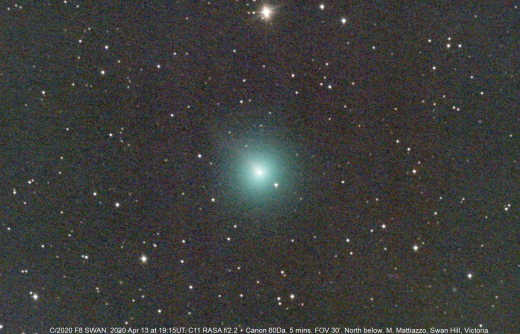Warning: This story may give you a sense of déjà vu.
Source: Spaceweather.com
A new comet has been discovered, and in late May it will pass by the sun near the orbit of Mercury. No, it’s not Comet ATLAS (C/2019 Y4), which is currently falling apart on a similar trajectory. Instead, this is Comet SWAN (C/2020 F8):

Michael Mattiazzo of Swan Hill, Victoria, Australia, took the picture on April 13th. “This is a 5 minute exposure through my 11-inch Celestron telescope,” says Mattiazzo. “A visual observation using 15x70mm binoculars gave a magnitude of 8.1.”
Mattiazzo discovered the comet two days earlier when he was looking at data from the Solar and Heliospheric Observatory (SOHO). It suddenly appeared in images from SOHO’s SWAN instrument. “This is my 8th discovery credit for SWAN comets since 2004 and I do check the data on most days,” says Mattiazzo.
Post-discovery images taken by Italian astronomer Ernest Guido and colleagues confirm that the comet is bright (8th magnitude), green, and has a long tail:

“We took this picture on April 11th–the same day Mattiazzo found the comet in SWAN data,” says Guido. “We couldn’t see it from Italy, so we used a remote-controlled 0.1 meter telescope in Australia.”
SOHO’s SWAN instrument was not designed to find comets. Its job is to survey the solar system for hydrogen. When the solar wind blows into a cloud of hydrogen-bearing compounds, the impact produces UV photons that SWAN can photograph.
“For SWAN to see a comet, it means the comet must be producing a fairly significant amount of hydrogen,” explains Karl Battams of the Naval Research Lab in Washington DC. “This is usually in the form of water-ice.”
“It’s extremely likely that Comet SWAN is in ‘outburst’ mode,” he continues. “That is, some major eruption happened to this otherwise small and faint comet, releasing a massive cloud of hydrogen-rich volatiles. SWAN is picking up on this sudden dump of hydrogen into the inner solar system.”
If the outburst continues, Comet SWAN could become visible to the naked eye next month. Preliminary light curves suggest that it could reach 3rd magnitude–dim, but visible without optics. However, Battams, who correctly predicted the demise of Comet ATLAS, is not so sure.
“I doubt that the comet will maintain its current impressive appearance, and will quite possibly fade away soon,” he says. “But we’ve only been viewing it for a couple of days, so no one knows.”
Source: Spaceweather.com

































Leave a Comment
You must be logged in to post a comment.